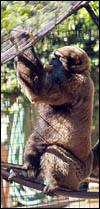| (Clicking
on the thumbnail images will launch a new window and a larger version
of the thumbnail.) |
| Last
updated: |
Lagothrix lagotricha
Order: Primates
Family: Cebidae
1) General Zoological Data
Nowak (1999) lists two species of woolly monkey: L. lagotricha and L. flavicauda. Groves (2001) calls the latter species Oreonax flavicauda. He also differentiates four subspecies. Adults weigh between 5,5 and 10.8 kg. Next to the howler monkey, they are the largest South American primates and are primarily frugivorous. Longevity in captivity is 25+ years. Gotch (1979) derived the name from "lagos" = hare and "thrix" = hair, as "an allusion to the woolly, hare-like fur, as the hair is unusually thick. Schneider (2000) presented the current knowledge of New World phylogeny as derived from DNA analysis. In the ateline clade the howler monkey represents the basal lineage and Brachyteles/Lagothrix are classed as sister group and the most derived branch.
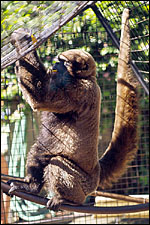 |
Adult woolly monkey. |
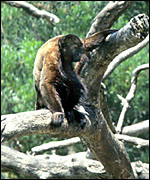 |
Adult woolly monkey. |
The length of gestation is 225 days and usually singletons are born that weigh around 140 g.
3) Implantation
The time of implantation has not been studied in woolly monkeys and early specimens have not been described. Other cebids have antimesometrial implantation in their uterus simplex. The placenta available to me was fragmented, bidiscoid and not well enough preserved for histologic representation. It was similar in all respects to that of the spider monkey (see chapter on Ateles).
4) General Characterization of
the Placenta
Young (1972) is the only author I have found to have reported specifically
on woolly monkey placentas. He found in two singleton births one placenta
to possess two discs, and one that had a single disc. This is a relatively
superficially implanted discoid (bidiscoid) hemochorial placenta.
5) Details of fetal/maternal barrier
The villi are bathed in maternal blood. The villous surface is syncytium,
the cytotrophoblast is quite inapparent in routine sections but is probably
present electronmicroscopically. This is similar to the placenta of spider
monkeys (Ateles sp.) The maternal blood circulates in the intervillous
space (IVS) and surrounds the villi with their syncytial surfaces. Syncytial
"buds" are commonly found on the villous surfaces and one would
expect that, as in humans, they would often detach and land in the maternal
lung, as happens in humans.
6) Umbilical cord
Young (1972) found two arteries and two veins in his two placentas wit
a Hyrtl anastomosis of arteries. There also were allantoic ducts, as in
Ateles, and remnants of a vitelline duct in one. One cord had
marginal, the other velamentous insertion.
7) Uteroplacental circulation
This has not been studied.
8) Extraplacental membranes
Young (1972) described the allantoic sac as a "simple elongated oval
sac lying beside the yolk sac and extending out on the surface of the
disc between the amnion and the chorionic plate". The same feature
occurs in spider monkey placentation. amnion/allantois, vitelline
9)
Trophoblast external to barrier
Despite alleged generally superficial placentation of Cebidae, extravillous
trophoblast ("X-cells") is found in the decidua basalis and
having modified the maternal uterine arterioles, very much as occurs in
Ateles sp. This is well shown in the following photograph of
a post partum uterus.
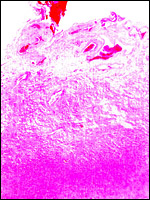 |
Post partum uterus with minimal membranes attached to top left of endometrium. The maternal arterioles (top center) are modified by extravillous trophoblast infiltration. |
Typical decidua develops during gestation.
11) Various features
None.
12) Endocrinology
I am not aware of any published studies.
Woolly monkeys have 62 chromosomes. The karyotypes shown below are from Hsu & Benirschke (1975). Some polymorphisms identified in our "frozen zoo" show minor banding polymorphisms of defined subspecies as shown below. Additional information and measurements can be found by Koiffmann & Saldanha (1974). Dutrillaux et al. (1980) had identified with detailed banding procedures of chromosome marked similarities to the human complement, but Stanyon et al. (2001) showed with chromosomal painting and sorting procedures even more remarkable homologies. Gray (1972) listed an abortion occurring in a hybrid between L. lagotricha x L. cana poeppigi.
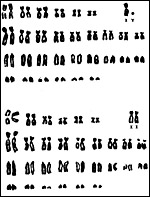 |
Karyotypes of Lagothrix ubericolor (same as L. cana cana) from the Houston Zoo. |
 |
Banding polymorphisms in different subspecies. |
No studies are known to me.
15) Pathological features
Griner (1983) found primarily parasitic, infectious and renal disease in a variety of woolly monkeys he autopsied. Brown et al. (2000) also identified glomerulonephritis (with pulmonary hemorrhage) in a woolly monkey. Giddens et al. (1987) reported spontaneous hypertension to occur in woolly monkeys. Rickets has been a known problem in European collections. Scott (1992) described esophagitis and colitis in woolly monkeys. An outbreak of toxoplasmosis was reported by Bouer et al. (1999). Lanford et al. (1998) reported isolation of a hepatitis-B virus from a woolly monkey with fulminant hepatitis and, from analysis of its nucleotide sequence, they concluded that it may represent a "progenitor of the human viruses".
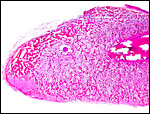 |
Rickets in a zoo-kept woolly monkey. |
The ovaries of all Atelinae are relatively large and, as other members, there is a large interstitial gland in Lagothrix. As Mossman & Duke (1973) stated, it is difficult to differentiate these from accessory corpora lutea but the shape of the pink masses shown next suggest that much of it is luteinized granulosa.
 |
Adult ovary of woolly monkey with large amount of luteinized tissue and small amount of "interstitial gland". |
 |
Higher magnification of ovary showing the fusion of granulosa with interstitial gland. |
A few cell strains are available from CRES at San Diego Zoo by contacting Dr. O. Ryder at oryder@ucsd.edu.
18) Other remarks - What additional
Information is needed?
Many more placental observations are needed, as are measurements of cord
length.
Acknowledgement
The animal photographs in this chapter come from the Zoological Society
of San Diego. Some material has been made available by Dr. Heldstab, then
at Zoo Basel.
References
Bouer, A., Werther, K., Catao-Dias, J.L. and Nunes, A.L.: Outbreak of
toxoplasmosis in Lagothrix lagotricha. Folia Primatol. 70:282-285,
1999.
Brown, P.J., MacIver, A.G., Harrison, R.F., Day, M.J., Skuse, A.M. and Munnings, N.P.: Fibrillary glomerulonephritis and pulmonary haemorrhage in a Woolly monkey (Lagothrix lagotricha). J. Comp. Pathol. 122:209-212, 2000.
Dutrillaux, B., Couturier, J. and Fosse, A.M.: The use of high resolution banding in comparative cytogenetics: comparison between man and Lagothrix lagotricha (Cebidae). Cytogenet. Cell Genet. 27:45-51, 1980.
Giddens, W.E., Combs, C.A., Smith, O.A. and Kline, E.C.: Spontaneous hypertension and its sequelae in woolly monkeys (Lagothrix lagotricha). Lab. Animal Sci. 37:750-756, 1987.
Gotch, A.F.: Mammals - Their Latin Names Explained. Blandford Press, Poole, Dorset, 1979.
Gray, A.P.: Mammalian Hybrids. A Check-list
with Bibliography. 2nd edition.
Commonwealth Agricultural Bureaux Farnham Royal, Slough, England, 1972.
Griner, L.A.: Pathology of Zoo Animals. Zoological Society of San Diego, San Diego, California, 1983.
Groves, C.: Primate Taxonomy. Smithsonian Institution Press, Washington, D.C. 2001.
Hsu, T.C. and Benirschke, K.: And Atlas of Mammalian Chromosomes. Springer-Verlag, N.Y. Folio Vol. 9:448, 1975.
Koiffmann, C.P. and Saldanha, P.H.: Cytogenetics of Brazilian monkeys. J. Human Evol. 3:275-282, 1974.
Lanford, R.E., Chavez, D., Brasky, K.M., Burns, R.B. 3rd and Rico-Hesse, R.: Isolation of a hepadnavirus from the woolly monkey, a New World primate. Proc. Natl. Acad. Sci. USA 95:5757-5761, 1998.
Mossman, H.W. and Duke, K.L.: Comparative Morphology of the Mammalian Ovary. University of Wisconsin Press, Madison, Wisconsin, 1973.
Nowak, R.M.: Walker's Mammals of the World. 6th ed. The Johns Hopkins Press, Baltimore, 1999.
Schneider, H.: The current status of the New World monkey phylogeny. An. Acad. Bras. Cienc. 72:165-172, 2000.
Scott, G.B.D.: Comparative Primate Pathology. Oxford University Press, 1992.
Stanyon, R., Consigliere, S., Bigoni, F., Ferguson-Smith, M., O'Brien, P.C. and Wienberg, J.: Reciprocal chromosome painting between a New World primate, the woolly monkey, and humans. Chromosome Res. 9:97-106, 2001.
Young, A.: The primate umbilical cord with special reference to the transverse communicating artery. J. Human Evol. 1:345-359, 1972.
